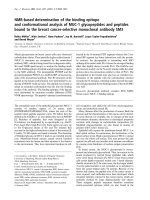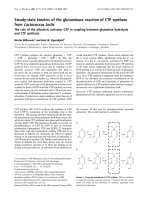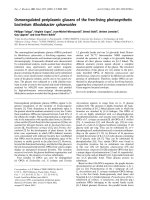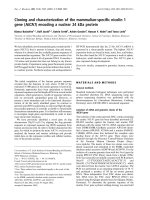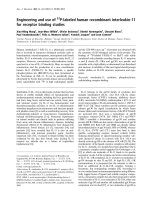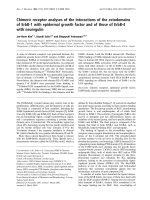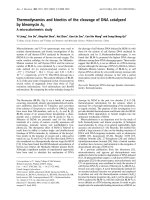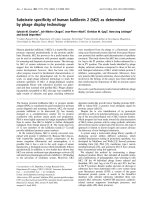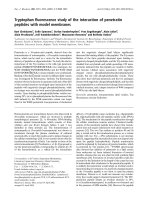Báo cáo y học: " Pneumatosis cystoides intestinalis of the ascending colon related to acarbose treatment: a case report" doc
Bạn đang xem bản rút gọn của tài liệu. Xem và tải ngay bản đầy đủ của tài liệu tại đây (1.55 MB, 5 trang )
Case report
Open Access
Pneumatosis cystoides intestinalis of the ascending colon
related to acarbose treatment: a case report
Yilin Vogel
1
, Nikolaus J Buchner
1
, Michael Szpakowski
2
,
Andrea Tannapfel
3
and Bernhard F Henning
1
*
Addresses:
1
Department of Internal Medicine I, Marienhospital Herne, Ruhr-University Bochum, Hölkeskampring 40, 44625 Herne, Germany
2
Department of Radiology, Marienhospital Herne, Ruhr-University Bochum, Bochum, Hölkeskampring 40, 44625 Herne, Germany
3
Department of Pathology, Berufsgenossenschaftliches Universitätsklinikum Bergmannsheil, Ruhr-University Bochum, Bürkle de la Camp-Platz 1,
44789 Bochum, Germany
Email: YV - ; NJB - ; MS - ; AT - ;
BFH* -
* Corresponding author
Received: 2 November 2008 Accepted: 18 June 2009 Published: 8 September 2009
Journal of Medical Case Reports 2009, 3:9216 doi: 10.4076/1752-1947-3-9216
This article is available from: />© 2009 Vogel et al.; licensee Cases Network Ltd.
This is an Open Access article distributed under the terms of the Creative Commons Attribution License (
/>which permits unrestricted use, distribution, and reproduction in any medium, provided the original work is properly cited.
Abstract
Introduction: Pneumatosis cystoides intestinalis is characterized by the presence of multiple gas-
filled cysts in the intestinal wall, the submucosa and/or subserosa of the intestine. The term
pneumatosis cystoides coli is synonymous with pneumatosis cystoides intestinalis when the disorder
is limited to the colon. It is a secondary finding caused by a wide variety of underlying gastrointestinal
or extragastrointestinal diseases but rarely occurs in the course of treatment with an a-glucosidase
inhibitor. This is the first report of pneumatosis cystoides intestinalis after 12 years of treatment with
the a-glucosidase inhibitor acarbose.
Case presentation: A 65-year-old Caucasian German woman was referred to our hospital for
hemicolectomy. She had been treated for type 2 diabetes mellitus with an a-glucosidase inhibitor
(acarbose, 150 mg daily) for 12 years. Three months before referral, she had complained of left
abdominal pain. ‘Polyposis coli’ in the ascending colon and diverticulosis were diagnosed.
Colonoscopy and computed tomography scans of the abdomen were repeated and revealed
pneumatosis cystoides coli located in the ascending colon, whereas diverticulosis of the sigmoid colon
was confirmed. Histological examination of a biopsy specimen only showed colon mucosa. After
discontinuing administr ation of the a-glucosidase inhibitor for 3 months and on repeated
colonoscopy, the polypoid lesions had completely disappeared.
Conclusion: This case illustrates that pneumatosis cystoides coli can be a source of diagnostic
confusion. Pneumatosis cystoides coli must be considered in the initial differential diagnosis of
patients especially in the presence of multiple colonic polypoid lesions. It is important to take
pneumatosis cystoides intestinalis into consideration when prescribing a-glucosidase inhibitors to
patients with diabetes who have diabetic autonomic neuropathy with decreased intestinal motility,
or to patients taking steroids.
Page 1 of 5
(page number not for citation purposes)
Introduction
Pneumatosis cystoides intestinalis (PCI), defined as the
presence of gas inside the intestinal wall, may be located in
any part of the gastrointestinal tract. In PCI, gas is found in
a linear or cystic form in the subserosa or submucosa [1].
The subserous cysts are most frequently found in the small
bowel while the submucous localizations are predomi-
nantly seen in the colonic wall [2]. PCI is a secondary
finding caused by a wide variety of underlying gastro-
intestinal or extragastrointestinal diseases such as auto-
immune (scleroderma, dermatomyositis), inflammatory
(inflammatory bowel diseas e), or infectious disease s
(Clostridium difficile, HIV), pulmonary disease (chronic
obstructive pulmonary disease), drugs (corticosteroids,
immunosuppressive therapy), and trauma (blunt abdom-
inal trauma, endoscopy).
In most cases, PCI presents with mild gastrointestinal
symptoms. Symptoms include diarrhea, mucus discharge,
rectal bleeding and constipation [3]. The diagnosis is
suspected by endoscopy and confirmed by computed
tomography (CT) and histological examination of biopsy
specimens. The endoscopic differential diagnosis of more
common diseases can be difficult. In the colon, gas-filled
cysts are often misdiagnosed as polyps, carcinoma,
lymphoma, and colitis cystica profunda.
Patients may be treated with oxygen and/or antibiotics.
Urgent surgical intervention is only required in rare cases
of PCI with perforation and necrotic bowel.
Case presentation
A 65-year-old Caucasian German woman complained of
left abdominal pain 3 months before referral. Under the
suspected diagnosis of acute sigmoid diverticulitis, she had
received nonspecific antibiotic therapy with ciprofloxacin
for 5 days. Two weeks later, colonoscopy rev ealed
numerous polypoid lesions located in the ascending
colon. The histology of a biopsy specimen revealed normal
colon mucosa. Nevertheless, she was referred to our
hospital for hemicolectomy with the diagnosis still
suspected to be polyposis coli.
Non-insulin-dependent diabetes mellitus had been diag-
nosed 12 years earlier. Since then, she had taken 150 mg
acarbose every day. There were no other episodes of
abdominal problems during that 12-year period.
Her medical history included hypertension, typhus abdo-
minalis with ulcer 57 years previously, and hysterectomy
and ovariectomy one year previously.
Physical examination showed normal blo od pressure
(120/60 mmHg), regular heart rate (76 beats/minute),
and a body temperature of 36.6°C. Heart sounds were
clear and the rhythm was regular; breath sounds were
normal without rales or bronchial obstruction. The abdo-
men was not distended and regular peristaltic sounds were
audible. Neurological examination revealed no patholo-
gical findings, in particular, no signs of diabetic poly-
neuropathy. Laboratory tests revealed the white blood cell
count and C-reactive protein levels to be normal, but
blood sugar (120 mg/dl) and HbA1c levels (6.3%) were
raised.
We repeated a colonoscopy and it revealed multiple
polypoid formations of varying sizes (1-3 cm) in the
ascending colon, covered by normal mucosa with super-
ficial vessels (Figure 1), and diverticulosis of the sigmoid
colon. After biopsy, the cysts collapsed and disappeared.
Furthermore, only colon mucosa was found in the biopsy
specimens (Figure 2). While X-ray film of the abdomen
did not reveal any pathological findings, CT confirmed
conspicuous gas bubbles in the ascending colon
(Figure 3).
At that time, we stopped the acarbose treatment. Whilst a
diabetes diet was continued, neither further oral antidia-
betics nor insulin were required to co ntrol diabetes
mellitus. Additionally, the patient was treated with
oxygen for 7 days (3 L/minute intranasally). After having
discontinued the acarbose treatment for 3 months, the
gas-filled cysts disappeared completely, as demonstrated
by colonoscopy. Fortunately, the patient had not under-
gone hemicolectomy for initially suspected ‘polyposis
coli’. The patient has remained free of abdominal
symptoms for a further 19 months.
Figure 1. Colonoscopy examination disclosed multiple
polypoid lesions that were covered with inconspicuous
mucosa with superficial vessels in the area of the ascending
colon.
Page 2 of 5
(page number not for citation purposes)
Journal of Medical Case Reports 2009, 3:9216 />Discussion
The pathogenesis of PCI is still unclear and several
mechanisms have been postulated for its development.
The mechanical theory proposes that gas diffuses into the
intestinal wall from either the intestinal lumen or the
pulmonary airway. The diffusion of intraluminal gas into
the i ntestinal wall is due to increased intraluminal
pressure and the presence of mucosal injury [4,5].
Additionally, gas might travel from ruptured alve oli
through the mediastinum into the retroperitoneal space
and find its way into the intestinal wall along perivascular
spaces through the mesentery [6]. Alternativel y, the
bacterial theory suggests that gas-producing bacter ia
entering the intestinal wall through a mucosal lesion
form intramural gas [7], thus forming cysts.
Acarbose, an a-glucosidase inhibitor, is a hypoglycemic
agent that can suppress postprandial hyperglycemia
by delaying absorption of carbohydrates in the small
intestine through antagonistic as well as dose-dependent
suppression of a-glucosidase (a-GI). Well-known side
effects of a-GIs include flatulence and abdominal disten-
sion resulting from fermentation by intestinal bacteria that
produce carbon dioxide, methane and hydrogen from
unabsorbed carbohydrates [8].
Our patient did not experience abdominal distension or
flatulence. Nevertheless, she probably had elevated intra-
luminal pressure because she had diverticulosis of the
sigmoid colon, possibly as a result of elevated intraluminal
pressure and reduced power of resistance of the intestinal
wall. We found one report regarding pneumatosis
cystoides coli (PCC) located in the sigmoid colon due to
a solitary sigmoid diverticulum- the patient was treated
with corticosteroids for periarteritis nodosa [9]. In our
patient, diverticulosis of the sigmoid colon was most likely
not responsible for PCC in the ascending colon.
The term pneumatosis cystoides coli (PCC) is synon-
ymous with pneumatosis cystoides intestinalis (PCI) when
the disorder is limited to the colon. In our patient, we
suppose that PCC was basically caused by acarbose. Two
months after her initial presentation, no regression of PCC
was found via colonoscopy during continuation of her
treatment with acarbose. However, after discontinuing
treatment with acarbose for 3 months, the PCC located in
the ascending colon had completely disappeared. It is
assumed that, in our patient, PCC developed from a
combination of the a-GI leading to elevated intraluminal
pressure from increased gas volume due to bacterial
overgrowth as well as mucosal damage in the ascending
colon due to elevated intraluminal pressure. We can only
speculate that the susceptibility to the formation of PCC
was due to colon mucosal vulnerability after the patient’s
typhus abdominalis with ulcer about 57 years previously.
There were no symptoms indicating previous episodes of
PCI in this patient. We believe that ageing and its related
changes to the colonic wall reached a critical point after
12 years, allowing gas invasion by intraluminal pressure.
Patients with PCI after acarbose treatment are generally
older, the youngest one being 53 years of age (Table 1).
In our patient, we used oxygen treatment applied by a
mask for 8 hours daily for 1 week. We did not use any
antibiotics. However, we do not definitely believe that
oxygen therapy basically caused regression of PCC, because
the patient was discharged home without oxygen therapy.
Figure 3. Abdominal computed tomography scan. Arrows
show intramural air in the ascending colon.
Figure 2. Muscularis mucosae in pneumatosis cystoides coli
from the ascending colon.
Page 3 of 5
(page number not for citation purposes)
Journal of Medical Case Reports 2009, 3:9216 />Table 1. Eight reported cases with pneumatosis cystoides intestinalis induced by a-glucosidase inhibitor administration for diabetes mellitus (modified from [10])
Author Age,
sex
Diabetes
mellitus +
Concomitant
drug
a-GI, daily dose,
duration
Main symptoms Localization Prescription of
a-GI+ after
onset of PCI
Outcome Treatment
Tsujimoto et al. [10] 69, M Myasthenia gravis Steroid SU Voglibose 0.6 mg
20 months
Increased flatus,
constipation,
hematochezia
Sigmoid colon Discontinuation Healing after
14 days
Conservative
Hisamoto et al. [11] 56, F Intestinal
pneumonitis
Steroid Voglibose 0.6 mg
7 days
Dyspnea, no
abdominal symptoms
Ascending colon Discontinuation Healing after
7 days
Conservative
Maeda et al. [12] 72, F Nephrotic
syndrome
Insulin Steroid
Immunosuppressant
Voglibose 0.9 mg
3 years
Abdominal pain, SIRS,
DIC
Discontinuation Healing after
7 days
Conservative
Saito et al. [13] 53, F Dermatomyositis Steroid
Immunosuppressant
Voglibose 0.6 mg
1 month
Nausea, flatulence Ascending colon +
descending colon
Discontinuation Healing after
21 days
Conservative
Yanaru et al. [14] 61, M Unknown SU Voglibose 0.6 mg
5 years
Constipation,
hematochezia
Sigmoid colon Discontinuation Healing after
28 days
Conservative
Azami [15] 87, F Hypothyroidism SU Acarbose 150 mg
1 year
Paralytic ileus,
abdominal distension
Small intestine Discontinuation Healing after
5 days
Conservative
Hayakawa et al. [16] 64, F Unknown Insulin Voglibose 0.6 mg
1 month
Abdominal distention,
flatulence
Ascending colon +
transverse colon
Discontinuation Healing after
4 days
Conservative
Furio et al. [17] 64, F Unknown Insulin Acarbose
unknown 3 years
Diarrhea, abdominal
pain, weight loss
Sigmoid colon
ascending colon +
descending colon
caecum
Discontinuation Healing after
15 days
Conservative
Our patient 65, F Hypertension Acarbose 150 mg
12 years
Left abdominal pain Ascending colon Discontinuation Healing after
7 days
Conservative
Six additional cases published in the Japanese language were recently reviewed by Tsujimoto et al. [10]. a-GI, a-glucosidase inhibitor; M, male; F, female; SIRS, systemic inflammatory response syndrome;
DIC, disseminated intravascular coagulation; SU, sulfanylurea.
Page 4 of 5
(page number not for citation purposes)
Journal of Medical Case Reports 2009, 3:9216 />Chronic obstructive pulmonary disease is often related to
the development of pneumatosis intestinalis but was
excluded in this patient. Our patient did not show signs of
diabetic polyneuropathy. Even though, from her medical
history, she did not have constipation, we cannot exclude
a diabetic autonomic neuropathy with decreased colonic
motility.
A review of the international literature revealed eight
cases of PCI (Table 1) associated with treatment with
a-GI; seven out of the eight patients were Japanese and
one was Italian. In addition, Tsujimoto et al. reviewed
another six cases reported in the Japanese language [10].
We postulate that a-GI may be prescribed more often in
Japan and/or diagnosis (via CT and colonoscopy) is
reached more often in Japan than in other countries, and/
or Japanese patients with PCI have more clinical
symptoms (Table 1: six out of the seven Japanese cases
reported). In contrast with a statistical study of 919 cases
by Jamart [2] (male to female ratio: 1.9:1), only two of
the eight cases reported in Table 1 were male. Tsujimoto
et al. found a peak incidence between 52 and 87 years
[10], which is higher than the 41 and 50 year range
reported by Jamart [2]. The difference in peak incidence
may be due to the differing ethnicity of the two groups; or
it may be related to the fact that the patients all had type
2 diabetes mellitus, suggesting that PCI may take more
time to develop in some people with diabetes. PCI
usually affects the left side of the colon and 70% of cases
involve the sigmoid colon [2,3].
The duration of a-GI treatment before presentation of
PCI has been reported elsewhere as 7 days to 5 years, but
it was 12 years in our patient.
Conclusion
This case report illustrates that PCI can be a source of
diagnostic confusion. PCI should be considered in the
initial differential diagnosis of patients, especially in the
presence of colonic multiple polypoid lesions. It is also
important to take PCI into consideration when prescribing
a-GI to patients who have diabetes and diabetic auto-
nomic neuropathy or to patients taking steroids.
Abbreviations
a-GI, a-glucosidase inhibitor; CT, computed tomography;
PCC, pneumatosis cystoides coli; PCI, pneumatosis
cystoides intestinalis.
Consent
Written informed consent was obtained from the patient
for publication of this case report and any accompanying
images. A copy of the written consent is available for
review by the Editor-in-Chief of this journal.
Competing interests
The authors declare that they have no competing interests.
Authors’ contributions
YV conceived the case report, drafted and revised the
manuscript, and reviewed the relevant literature. NJB
made a substantial contribution to drafting and revision of
the manuscript. MS and AT helped to interpret the
radiological and histological findings and reviewed the
manuscript. BFH made a substantial contribution to
conception and design, interpreted the case and helped
in drafting the manuscript. All authors read and approved
the final manuscript.
References
1. Heng Y, Schuffler MD, Haggitt RC, Rohrmann CA: Pneumatosis
intestinalis: a review. Am J Gastroenterol 1995, 90:1747-1758.
2. Jamart J: Pneumatosis cystoides intestinalis. A statistical study
of 919 cases. Acta Hepatogastroenterol (Stuttg) 1979, 26:419-422.
3. Gagliardi G, Thompson IW, Hershman MJ, Forbes A, Hawley PR,
Talbot IC: Pneumatosis coli: a proposed pathogenesis based
on study of 25 cases and review of the literature. Int J Colorectal
Dis 1996, 11:111-118.
4. Gillon J, Tadesse K, Logan RF, Holt S, Sircus W: Breath hydrogen in
pneumatosis cystoides intestinalis. Gut 1979, 20:1008-1011.
5. Hughes DT, Gordon KC, Swann JC , Bo lt GL: Pneumatosis
cystoides intestinalis. Gut 1966, 7:553-557.
6. Keyting WS, McCarver RR, Kovarik JL, Daywitt AL: Pneumatosis
intestinalis: a new concept. Radiology 1961, 76:733-741.
7. Read NW, Al-Janabi MN, Cann PA: Is raised breath hydrogen
related to the pathogenesis of pneumatosis coli? Gut 1984,
25:839-845.
8. Joubert PH, Venter HL, Foukaridis GN: The effect of miglitol and
acarbose after an oral glucose load: a novel hypoglycaemic
mechanism? Br J Clin Pharmacol 1990, 30:391-396.
9. Jørgensen A, Wille-Jørgensen P: Pneumatosis intestinalis and
pneumoperitoneum due to a solitary sigmoid diverticulum.
Acta Chir Scand 1982, 148:625-626.
10. Tsujimoto T, Shioyama E, Moriya K, Kawaratani H, Shirai Y,
Toyohara M, Mitoro A, Yamao J, Fujii H, Fukui H: Pneumatosis
cystoides intestinalis following alpha-glucosidase inhibitor
treatment: a case report and review of the literature. World
J Gastroenterol 2008, 14:6087-6092.
11. Hisamoto A, Mizushima T, Sato K, Haruta Y, Tanimoto Y,
Tanimoto M, Matsuo K: Pneumatosis cystoides intestinalis
after alpha-glucosidase inhibitor treatment in a patient with
interstitial pneumonitis. Intern Med 2006, 45:73-76.
12. Maeda Y, Inaba N, Aoyagi M, Kanda E, Shiigai T: Fulminant
pneumatosis intestinalis in a patient with diabetes mellitus
and minimal change nephrotic syndrome. Intern Med 2007,
46:41-44.
13. Saito M, Tanikawa A, Nakasute K, Tanaka M, Nishikawa T: Additive
contributio n of multiple factors in the development of
pneumatosis intestinalis: a case report and review of the
literature. Clin Rheumatol 2007, 26:601-603.
14. Yanaru R, Hizawa K, Nakamura S, Yoshimura R, Watanabe K,
Nakamura U, Yoshinari M, Matsumoto T: Regression of pneumatosis
cystoides intestinalis after discontinuing of alpha-glucosidase
inhibitor administration. J Clin Gastroenterol 2002, 35:204-205.
15. Azami Y: Paralytic ileus accompanied by pneumatosis
cystoides intestinalis after acarbose treatment in an elderly
diabetic patient with a history of heavy intake of maltitol.
Intern Med 2000, 39:826-829.
16. Hayakawa T, Yoneshima M, Abe T, Nomura G: Pneumatosis
cystoides intestinalis after treatment with an alpha-glucosi-
dase inhibitor. Diabetes Care 1999, 22:366-367.
17. Furio L, Vergura M, Russo A, Bisceglia N, Talarico S, Gatta R,
Tomaiu olo M, Tomaiu olo P: Pneumatosis coli induced by
acarbose administration for diabetes mellitus. Case report
and literature review. Minerva Gastroenterol Dietol 2006, 52:339-346.
Page 5 of 5
(page number not for citation purposes)
Journal of Medical Case Reports 2009, 3:9216 />
